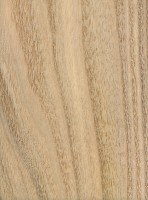 |
Common Name(s): Catalpa Scientific Name: Catalpa spp. (C. speciosa and C. bignonioides) Distribution: Native to eastern United States, but naturalized throughout North America Tree Size: 50-100 ft (15-30 m) tall, 2-4 ft (.6-1.2 m) trunk diameter Average Dried Weight: 29 lbs/ft3 (460 kg/m3) Specific Gravity (Basic, 12% MC): .38, .46 Janka Hardness: 550 lbf (2,450 N) Modulus of Rupture: 9,400 lbf/in2 (64.8 MPa) Elastic Modulus: 1,210,000 lbf/in2 (8.35 GPa) Crushing Strength: 2,740 lbf/in2 (18.9 MPa) Shrinkage: Radial: 2.5%, Tangential: 4.9%, Volumetric: 7.3%, T/R Ratio: 2.0 |
Color/Appearance: Heartwood color can range from a neutral grayish tan to a richer golden brown: nearly the entire trunk is composed of heartwood. Narrow sapwood is a pale gray. Overall appearance somewhat resembles ash.
Grain/Texture: Grain is straight, with an open, coarse texture.
Endgrain: Ring-porous; 3-8 rows of very large earlywood pores, large to small latewood pores in wavy tangential bands; tyloses common; parenchyma vasicentric, confluent, and marginal; narrow rays, normal spacing.
Rot Resistance: Catalpa is rated as being durable regarding decay resistance, and holds up well in direct ground contact.
Workability: Generally easy to work with hand and machine tools, though care must be taken during sanding to avoid creating indents and ridges where the lighter latewood areas tend to sand more readily than the earlywood portions. (Using a rigid-backed sanding block is recommended.) Turns, glues, and finishes well, though pore-filling is necessary to obtain a smooth finished surface.
Odor: Catalpa has a faint, spicy odor.
Allergies/Toxicity: Although severe reactions are quite uncommon, some species of Catalpa have been reported to cause skin irritation. See the articles Wood Allergies and Toxicity and Wood Dust Safety for more information.
Pricing/Availability: Although the trees are widespread across the United States, the trees tend to be scattered irregularly throughout its range: thus Catalpa is not always consistently available as lumber. Prices are likely to be moderate for boards—or perhaps a bit above average for specialty-sized blocks such as turning or carving blanks.
Sustainability: This wood species is not listed in the CITES Appendices or on the IUCN Red List of Threatened Species.
Common Uses: Fence posts, utility wood, cabinetry, and carving.
Comments: There are a total of only eleven species worldwide, with only two species—Northern Catalpa and Southern Catalpa (C. speciosa and C. bignonioides, respectively)—native to North America. The genus gets its name from the Catawba Indian tribe’s name for the tree, (the tribe itself is also named after the tree). Catalpa is a popular ornamental tree, with showy flowers, broad leaves, and large, characteristic bean-like fruit; the latter of which lead some to refer to the trees as the Indian bean tree, or the cigar tree.
Catalpa is a somewhat underrated hardwood, not seen too often in lumber form. Unlike most other common carving woods, such as Butternut or Basswood, Catalpa is resistant to decay, and is more suited to outdoor carvings than other domestic species. Additionally, Catalpa has superb stability, with very low shrinkage rates, (though initial drying can be problematic, with checking a common problem on unsealed pieces).
None available.
Scans/Pictures: A special thanks to Salem Barker for providing the sculpture photo of this wood species.


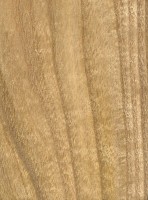
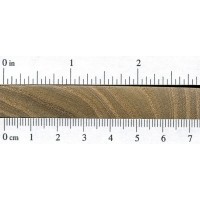
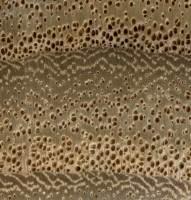
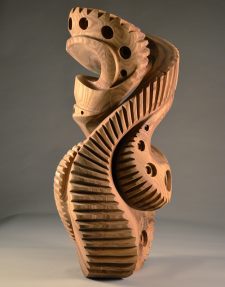



Since no one mentioned it, I thought your readers would find it interesting that ypthe wood stocks of the Chinese SKS rifle are predominantly catalpa, although I do not know which species is native to China.
Outside patio
I just finished making a coffee table for my outside deck , I love the grain it’s very consistent . I’m hoping to get more so I can make chairs .
Can Catalpa wood be used as firewood?
Any wood can be. They will have different burning rates.
Not “any wood”. An example is Black Walnut of which the sanding dust as well as the smoke from burning it tends to be toxic. A respirator should be worn when sanding, and if you burn the wood avoid breathing in the smoke.
Yes , it is wise to avoid breathing in smoke. That’s true with everything burning & inhalation , you can burn Catawba , Black Walnut , or anything else outdoors in a campfire , airtight woodstove , or like anything else , mixed in a fireplace .
Bees ‘n’ Trees ?
Just found out the tree in my yard is a catalpa. I had a pretty good size branch break off in a storm and decided to try to get a few boards out of it. Posted it on reddit and once somebody suggested catalpa, I knew they were right. Wood is very easy to work and very pretty
I’m in the process of building a strip canoe from a Catalpa donated by a neighbor who had some large old trees taken down. It’s proved to be a very good wood for the purpose — light, strong and flexible.
Awesome idea
Any tip for drying a 3″ x 23″ round so it doesn’t get splits or cracks?
Microwave it dry, use a moisture meter after each 5 min / 50% power cycle.
I do wood turnings rough turn first then soak in denatured alcohol for about 2 hours then let dry. Just keep checking the weight with a scale it took about 5 weeks to dry. I did not end up with any cracks.
I suggest a different alcohol: denatured is intentionally toxic- not just internal consumption! toxix when inhaled, and through skin contact. the denaturing process is to add poison so it can be sold without liquor taxes. Otherwise it is just ethyl alcohol. All solvents are toxic, but this has added toxicity. Rubbing alcohol (isopropyl) is readily available (besides grocery store size containers) in gallon containers. probably also in drums.70% should do the trick and is less extensive than 91%.
Isopropyl alcohol is a denaturing agent and more toxic than denatured alcohol. Denatured alcohol is a dafe product made just dangerous enough not to consume and is less taxic. To see how toxic something is check the LD50 in the MSDS (and always check the MSDS). Isopropyl has LD50 of about 5mg/kg, denatured alcohol ranges over 1000 mg/kg; so isopropyl is about 200x more toxic.
Not sure if you are misreading something somewhere, but this seems to be just plain incorrect. Isopropyl alcohol has an oral LD50 of 5840 mg/kg, so you have apparently overstated its toxicity by about 1000x. https://www.sigmaaldrich.com/US/en/sds/SIAL/W292912 (See page 9.) It’s very possible you may have misread a value of 5 grams per kilogram as 5 MILLIgrams per kilogram, a difference of 1000x. Meanwhile, methyl alcohol (the denaturant most commonly used in denatured alcohol) has an oral LD50 of 5628 mg/kg, practically the same as isopropyl. https://www.sunnysidecorp.com/pdfs/SDS_834G5.pdf (See page 8.) As to the claim that denatured alcohol is made “just dangerous… Read more »
Working with it now. Beautiful wood. Very easy to work with. Making extention jambs, and trim for windows. Also covered accent wall with it. Going for rustic look so wood is rough sawn.
One of my local lumber companies is moving their warehouse and had a sale of 50 BdFt for $50! Just picked up 50 BdFt of some beautiful Catalpa… never worked with it before, but looking forward to getting started! Looks very similar to Ash.
Less than a week ago, four acres was cleared here in Springfield for the purpose of building yet another medical building. I noticed some of the wood being cleared was good-sized catalpa. I asked, and the manager said our wood club could have anything we wanted, also including oaks, walnut, silver maple, and lesser amounts of others, including the catalpa. I grabbed most of the stock from 6- to 12-inch diameter. I slice them into cookies and make trivets on which to set hot dishes being served on a varnished table, for instance. My past experience has shown that they… Read more »
Excellent wood for carving decoys for waterfowl hunting. Very good weathering properties.
The name derives from the Muscogee name for the tree, “kutuhlpa” meaning “winged head” and is unrelated to the name of the Catawba people.[5][6] The spellings “Catalpa” and “Catalpah” were used by Mark Catesby between 1729 and 1732, and Carl Linnaeus published the tree’s name as Bignonia catalpa in 1753.[7][8] Giovanni Antonio Scopoli established the genus Catalpa in 1777.
One old-time use for catalpa trees was to host “catalpa worms”. These caterpillars, which are larvae of the sphinx moth, were considered a premier fish bait. When I was a boy, our neighbor would pay us to gather them for him. The worms can strip a catalpa tree of leaves, but the trees seem to recover OK.
We used to pick em off a tree per my grandpa’s request and use them as fishing bait,which they were great for. I was kinda scarred though as a kid, because for them to be effective at night in the Tippecanoe River we had to turn them inside out on the tip of a bobber then hook them.
Is this wood considered food safe for carving spoons
Yes it is! I’ve carved about four kitchen utensils that have done very well in service- just don’t carve/mill it too thin, as it is a somewhat soft wood. I didn’t even finish mine, just left em plain. Carve away, friend…..
How many years can a catulpa log sit and still be cut into slabs? I have one that is been sitting for three years
The one I sliced into cookies 30 years ago was already dead, but still standing. The trees allegedly weather quite well. The test way to retain bark when harvesting a living tree, is to “cut” it in the dead of winter in temperate zone; i.e., January and February.
Very true. Good luck taking the bark off an oak or honey locust that’s been cut in the dormant season. I’d guess it could stay attached Indefinitely.
Could smoking pipes be carved from Catalpa?
I would perhaps risk saying the wood is too soft for such application. It’s possibly not even usable for contact with ember as I guess it could easily combust. There’s a reason pipes are usually made from specific dense woods. And there’s a reason why kindling is made from soft woods. The USDA has a fire spread index for different lumbers, but this index is probably not very telling in smoking pipe applications, since it looks at the index of spread, and not flammability, and is not very consistent or related to the wood density, since the spread of fire… Read more »
You would definitely taste the wood when using it, I’d imagine. It says faint spicy odor above but I don’t find it to be all that faint. It’s a kind of a loud earthy smell with a definitely spicy fragrance to it. I’d light a piece first and see if you think it would combine well with tobacco or what have you.
Hello
What is the best way to finish a catalpa board?
Please list the steps!
Thanks a bunch
Keep it simple. Your best choice will likely depend on the “use” of your item. For trivets I’d use a simple oil, like mineral oil, walnut oil, linseed oil, etc. If you want a protective finish you’ll likely want to stain it first as it’s a “light-colored” wood, rather tan. Polyurethane should be good, but several coats because catalpa is such a soft species. Expect alot of dents if regularly used.
I have used Tung oil on some pieces with great success, strictly for the visual appeal. A few days ago, I made some bread boards for my wife, from catalpa, and finished them out by planing, sanding to 220 grit, then #4/0 steel wool. The finish I chose was simple beeswax. They turned out beautifully, with the grain really showing out.
“The genus gets its name from the Catawba Indian tribe’s name for the tree, (the tribe itself is also named after the tree).“
THIS IS FALSE
The words catalpa and Catawba though both derived from Native American words have totally different origins and totally different meanings. Catawba (the tribe and the river) comes from
A Shawnee word that means “fork if the river”. Catalpa is derived from a Muscogee word that means “winged head”
I just started carving some catalpa today. It really is a nice wood. It does smell spicy too.